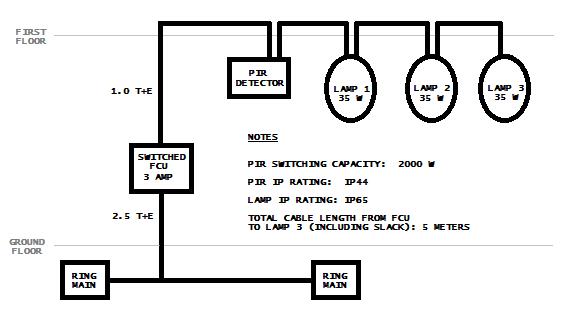Hi there,
I'm wanting to install three downlights in the wooden ceiling of a fairly substantial front porch, controlled by a PIR detector. The lights and the PIR will be recessed into the ceiling. The interior of the porch roof shows no sign of moisture or leakage and has been vacuumed to remove 80 years of dust/muck.
The downlights I'm using are GU10's rated at 35 watts max, IP 65 and are F-marked for insertion into combustible material. The PIR has a switching capacity of 2000 watts, and is rated as IP 44.
I have chosen to take a spur off the ring main (from a junction box) to a switched fused connection unit. The FCU will provide functional switching. 2.5 T&E from junction box to the FCU, 1.0 T&E thereafter to the PIR, and from the PIR to the three lamps. The total length of 1.0 T&E cable from FCU to Lamp 3 will be about 5-6 meters.
I've installed single lamps off fused spurs before (security floodlights), but never more than a single lamp - and that's where I'm confused. Can someone take a look at the wiring diagram and give me an idea if the proposed wiring of the lamps is correct?
Also, am I right using 1.0 T&E for the load, or should I be using 1.5 T&E? I'm assuming three 35w lamps (total of 105w) at 240v will demand less than half an amp (105/240=0.43), making 1.0 T&E appropriate?
I'm also aware that technically this would be a notifiable installation.
Any advice would be appreciated.
Thanks,
W
I'm wanting to install three downlights in the wooden ceiling of a fairly substantial front porch, controlled by a PIR detector. The lights and the PIR will be recessed into the ceiling. The interior of the porch roof shows no sign of moisture or leakage and has been vacuumed to remove 80 years of dust/muck.
The downlights I'm using are GU10's rated at 35 watts max, IP 65 and are F-marked for insertion into combustible material. The PIR has a switching capacity of 2000 watts, and is rated as IP 44.
I have chosen to take a spur off the ring main (from a junction box) to a switched fused connection unit. The FCU will provide functional switching. 2.5 T&E from junction box to the FCU, 1.0 T&E thereafter to the PIR, and from the PIR to the three lamps. The total length of 1.0 T&E cable from FCU to Lamp 3 will be about 5-6 meters.
I've installed single lamps off fused spurs before (security floodlights), but never more than a single lamp - and that's where I'm confused. Can someone take a look at the wiring diagram and give me an idea if the proposed wiring of the lamps is correct?
Also, am I right using 1.0 T&E for the load, or should I be using 1.5 T&E? I'm assuming three 35w lamps (total of 105w) at 240v will demand less than half an amp (105/240=0.43), making 1.0 T&E appropriate?
I'm also aware that technically this would be a notifiable installation.
Any advice would be appreciated.
Thanks,
W



